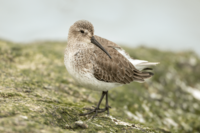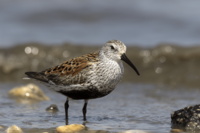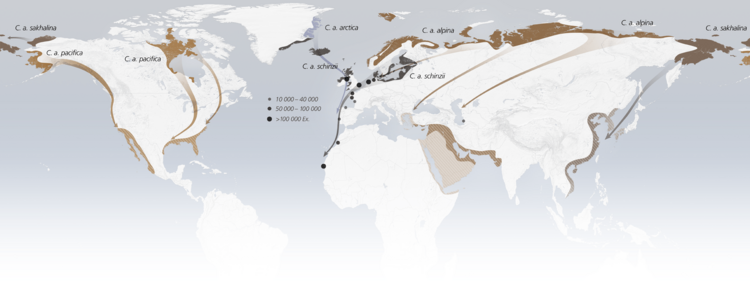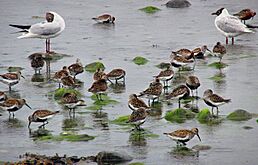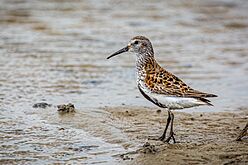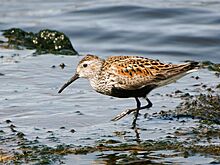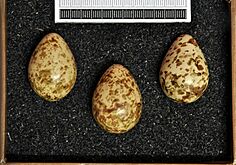Dunlin facts for kids
Quick facts for kids Dunlin |
|
|---|---|
 |
|
| A Dunlin in late September, UK | |
| Conservation status | |
| Scientific classification | |
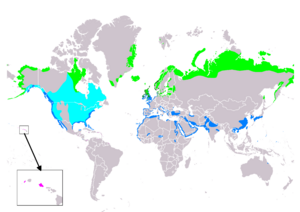 |
|
| Where Dunlins live: Breeding Resident Non-breeding Passage Vagrant (sometimes seen) |
The dunlin (Calidris alpina) is a small wader bird. Waders are birds that often wade in shallow water or mud. The name "dunlin" comes from an old word meaning "dull brown bird". It was first used a long time ago, around 1531.
These birds breed in cold Arctic or subarctic areas around the world. Many Dunlins are long-distance migrants. This means they fly very far to warmer places for winter. For example, birds from northern Europe fly to Africa or Asia. Those from Alaska might fly to the coasts of North America. Some even spend winter along the coast of Spain.
Contents
About the Dunlin's Name
The Dunlin was officially described by a Swedish scientist named Carl Linnaeus in 1758. He gave it the scientific name Tringa alpina. Later, it was moved to the group of birds called Calidris.
The name Calidris comes from an old Greek word. It was used for grey birds found near water. The second part of its name, alpina, is Latin. It means "from high mountains," like the Alps.
Different Types of Dunlins
There are ten different types, or subspecies, of Dunlins. They mostly look a bit different in their breeding feathers. Their bill length can also vary. Here are some of them:
- C. a. arctica — found in northeast Greenland
- C. a. schinzii — found in southeast Greenland, Iceland, the British Isles, and Scandinavia
- C. a. alpina — found in northern Europe and northwest Siberia
- C. a. centralis — found in north-central and northeast Siberia
- C. a. sakhalina — found in eastern Russia
- C. a. kistchinski — found around the Sea of Okhotsk
- C. a. actites — found on Sakhalin
- C. a. arcticola — found from northwest Alaska to northwest Canada
- C. a. pacifica — found in western and southern Alaska
- C. a. hudsonia — found in central Canada
What Dunlins Look Like
Dunlins are small birds.
- Length: About 16 to 22 centimeters (6.3 to 8.7 inches) long.
- Weight: Around 48 to 76 grams (1.7 to 2.7 ounces).
- Wingspan: About 36 to 38 centimeters (14.2 to 15.0 inches) wide.
When they are breeding, adult Dunlins have a special black belly. No other wader of their size has this. In winter, they are mostly grey on top and white underneath. Young Dunlins are brown on top. They have two whitish "V" shapes on their back. They might also have black marks on their sides or belly.
When they fly, you can see a clear white bar on their wings. Their legs and their slightly curved bill are black. Female Dunlins usually have longer bills than males. The tip of their bill is very sensitive. It helps them find food like worms in mud and sand.
Their call sounds like a typical sandpiper "peep." Their special song for showing off is a harsh trill.
Where Dunlins Live
Dunlins are small birds that travel a lot. They are known to return to the same places to breed. This is called "philopatry." For example, Dunlins in Sweden and Finland often go back to the exact same spots.
Sometimes, their natural homes are broken up into smaller pieces. This is called habitat fragmentation. It makes it harder for Dunlins to find good places to live. It also makes it harder for them to move between different areas. This can cause problems for their populations.
How Dunlins Behave
In winter, Dunlins often gather in very large groups. You can see them on muddy coasts or sandy beaches. Sometimes, huge flocks fly together in amazing swirling patterns. They do this when they stop during migration or in their winter homes.
The Dunlin is one of the most common wader birds. It is about the size of a common starling. But it is a bit sturdier and has a thicker bill.
Dunlins move along the mudflats like a "sewing machine." They pick up small food items very carefully. On their breeding grounds, they mostly eat insects. In coastal areas, they eat molluscs (like snails), worms, and crustaceans (like crabs).
Dunlin Breeding Habits
Dunlins make a simple nest on the ground. It is a shallow dip lined with plants. The female usually lays four eggs. Both the male and female birds take turns sitting on the eggs to keep them warm.
When the chicks hatch, they can move around very soon. This is called being "precocial." However, the parents still keep them warm and safe. The chicks start to fly when they are about three weeks old. The male Dunlin usually takes care of the young birds the most. The female often leaves the nesting area after the chicks hatch.
Dunlin Conservation Status
The Dunlin lives in a very large area around the world. Even though their numbers seem to be going down, there are still many Dunlins. Because of this, the International Union for Conservation of Nature (IUCN) says they are a species of "Least concern." This means they are not currently in danger of disappearing. The Dunlin is also protected by an agreement called AEWA. This agreement helps protect waterbirds that migrate between Africa and Eurasia.
Images for kids
-
A Dunlin in Ystad, Sweden
-
An adult Dunlin in breeding plumage, Spiekeroog, Germany



